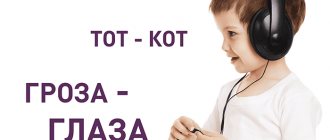Concept of speech hearing
The human hearing system has non-speech and speech hearing as two independent forms. The first form is the ability to navigate non-speech sounds, which include music, melodies, and noises. Speech hearing is the ability to analyze heard speech sounds. In this case, the origin of the words heard is not important - they can be taken from the native language or a foreign one. Speech hearing may be impaired due to injury to the temporal region on the left side of the head. Non-speech is impaired when the right temporal region is injured.
Speech hearing is divided into:
- phonemic – difference, recognition of phonemes in speech;
- physical – the ability to perceive sounds of different sounds, pitches and volumes;
- pitch – the ability to capture the melody of speech;
- tonal – the ability to hear and repeat changes in voice timbre;
- rhythmic - a sense of the internal tempo of speech and the ability to reproduce it.
Speech hearing allows you to control the spoken text, adapt to the tone of your interlocutor, control the auditory perception of speech and the sound of your own voice. With speech hearing impairments, problems arise in learning to read and write.
Which hemisphere is responsible for speech hearing?
A person perceives sounds with the help of the organ of Corti - a labyrinth in which sound cells float in the lymph. From here begins the complex path of sounds from the ear to the temporal part of the cerebral cortex - 41 fields. This zone is also called the auditory zone.
Depending on the frequency of sound vibrations, different cells are excited in individual parts of the organ of Corti. They act on nerve endings, and the vibrations are converted into nerve impulses that enter the cerebral cortex. Sounds of different pitches are directed to different areas of the cortex.
All information from the left and right ears first reaches both hemispheres of the brain. However, sounds are processed separately in special areas of the cortex. The left hemisphere of the brain is responsible for recognizing phonemes. But the right hemisphere also participates in speech hearing - it analyzes different voices and intonations.
What is phonemic awareness?
As mentioned earlier, phonemic awareness is the ability of a person to analyze and synthesize speech sounds that provide the perception of phonemes of a foreign or native language. Phonemes are the minimal units of the sound structure of a language, through which the construction and distinction of morphemes, words and entire sentences is carried out.
Phonemic hearing includes 3 speech operations:
- The ability to recognize the presence of a specific sound in a word.
- The ability to distinguish words that contain identical phonemes that are located in different orders.
- The ability to distinguish words that have different meanings, but have the same or similar sound.
Every language we know has its own set of phonemic features, which creates their sound structure.
Formation of speech hearing and pronunciation aspects of speech
The development of speech perception is closely related to the formation of speech. Sensations associated with the work of the organs of articulation improve the understanding of phonemes. As perception develops, the child begins to analyze the correctness of pronunciation, identify and correct errors.
Games have a positive effect on the development of hearing and speech. For example:
- "Broken phone". Children sit in a row. The first player comes up with a word and whispers it in his neighbor's ear. He passes on what he heard further. The last one in the chain says the word out loud. The goal of the game is to correctly hear and convey what is said.
- "Magic Mirror". The guys choose a leader. He approaches one of the players to choose from and says: “Come on, mirror, look, repeat everything to us correctly!” I will stand in front of you, and you repeat after me.” Then he makes a movement and says a short phrase. The player must repeat everything exactly. If he makes a mistake, he drops out of the game, if not, he becomes the leader.
The development of the pronunciation side of speech ends by 4–5 years. At 5 years old, the organs of articulation are sufficiently formed to clearly reproduce all sounds, with the exception of [р], [р']. Normally, a five-year-old child is also able to regulate the volume of speech, pronounce words correctly, construct sentences, and use different intonations.
How does speech hearing develop in preschool children?
The formation of speech hearing in children occurs in preschool age. This period is characterized by the active assimilation of spoken language, the formation and comprehensive development of speech. Early learning of the native language is the main condition in solving the problems of mental, moral and aesthetic education. And the sooner you start learning speech development, the easier it will be for the child to use the rules of his native language in the future.
The development of speech hearing has several tasks:
- Education of sound culture of speech.
- Expansion of vocabulary and its activation.
- Formation of grammatical structure of speech.
- Instilling coherent speech skills.
All these problems must be solved in preschool age. However, at each stage, the teaching methodology changes, and the content of speech work becomes more complex. In addition, each task has its own set of problems that need to be solved in a timely manner. After all, if you do not do this, improper speech development will lead to difficulties in upbringing and teaching, and the child’s mental development will be disrupted, which includes memory, thinking, and imagination.
To speak a language means to be able to communicate with people and understand society. At the age of 2 years, speech hearing is not sufficiently developed - the baby pronounces individual syllables and sounds. However, there is no speech as such yet.
By the age of 3, the baby still speaks poorly; he changes syllables in words, confuses sounds, shortens words or skips fragments in them. By the age of four, the structure of words with a large number of syllables lengthens. Sometimes a change in sounds is noticeable. At 5-6 years old, a preschooler speaks clearly and reproduces the correct structure of words.
But all this is possible if the baby has well-developed speech hearing. Otherwise, children are diagnosed with a violation of the formation of pronunciation due to defects in the reproduction and perception of phonemes. Moreover, underdevelopment of phonemic hearing leads to the inability to perform sound analysis of words.
The development of speech phonemic hearing in preschoolers is carried out through didactic games, various exercises, and activities. Of course, it is better if teachers do this. But parenting will also come in handy. But the main thing is that if there is a problem with a child’s speech hearing, you should not leave it to chance - seriously address it yourself or with the help of teachers.
Comments ()
Features of development
Speech perception begins to form from the first months of a child’s life. At 1 month, the baby can already pick up speech. At 3-4 months he tries to repeat it, which is manifested by humming. Every month he gets better at it.
The development of the ability to understand speech is greatly influenced by auditory attention and auditory memory. Long-term memory contains a storage device called the “phoneme lattice.” In it, for each phoneme a certain standard is assigned (allowing deviations within certain limits). In other words, during the formation of speech hearing, significant signs of sounds are stored in memory. The child accumulates a certain “baggage” of phonemes.
As concentration increases and other mental functions develop, speech perception also improves. The main development of speech hearing occurs in the first 2–3 years of a person’s life. And although the child is not yet able to reproduce everything correctly, in the absence of violations he fully understands his native language.
Speech hearing and speech culture
Speech culture is the ability to correctly use all language means: sounds, intonation, vocabulary, grammatical forms. A high culture of speech is characteristic of speakers, actors, poets, and journalists. Children master it in the process of communication, listening to fairy tales and poems. Speech hearing ensures correct pronunciation, capturing intonations, pauses, etc.
To improve speech culture, it is necessary to develop:
- correct speech breathing,
- control over voice strength, speech speed, intonation.
Features of speech development of children with hearing impairment
Overcoming phonemic perception disorders is one of the main areas of speech therapy work. A properly designed set of classes helps to completely solve the problem in 3–12 months. If indicated, correction is carried out against the background of drug treatment or after it.
Speech therapy work includes 3 stages:
- Development of the ability to distinguish sound from the background of a word.
- Developing the skill of isolating sounds at the beginning, end and middle of a word.
- Formation of complex phonemic analysis: number, sequence of sounds, location, etc.
All exercises are veiled - they are carried out in the form of interesting games. The complex is developed for each child individually, depending on the severity and nature of the disorders. The main work is carried out by a specialist. At home, it is also useful to play games with your child that develop physiological breathing, phonemic hearing, analysis, auditory attention and memory.
If you don't intervene in time, the problem will get worse. The developmental features of children with speech hearing impairment are clearly evident at school. Already from the first year of study, they find themselves in the category of lagging students . Impaired speech perception entails gross errors in writing: “breathing” instead of “sentence”, “leste” instead of “leaves”.
Speech hearing is an ability that develops independently in the absence of diseases and in a favorable social environment. Receiving speech sounds, the brain remembers them and creates certain “standards”. Later he focuses on them, correcting the correct pronunciation. That is why it is so important in the first years of life to talk with the child often, without resorting to baby talk, to read a lot, to learn poetry and tongue twisters. But even if time is lost or perception is impaired as a result of illness, one should not despair. Speech hearing, like musical hearing, can be developed throughout life. The main thing is not to let the problem take its course!
Development of speech hearing and breathing
Correct speech breathing is an integral component of expressive speech. To speak fluently in phrases, you need to be able to take a short breath and exhale smoothly and long. Children who cannot control their breathing “choke” mid-sentence, lose the sonority of their voice, and mumble their words. Pronunciation suffers, and along with it, speech hearing does not develop.
To develop phonemic hearing, classes are held, including on the development of speech breathing. Example exercise:
"Bubbles." Children repeat a poem after an adult and at the same time wave their brushes towards themselves: “Hey, little mouse, look, we’re blowing bubbles.” In the next part of the poem, before naming the color, you need to puff out your cheeks and quickly exhale: “Blue, red, light blue - choose any one!”
Normally, a child 2–3 years old can utter 2–3 words while exhaling, 3–4 years old – 3–5 words, 4–6 years old – 5–6 words.









